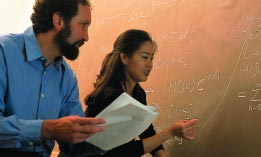Michael I. Miller and colleagues at the Center for Imaging Science are investigating research with some far-sighted applications.

On the third floor of the Whiting School’s Clark Hall, researchers are studying the theoretical underpinnings of how machines someday might understand what they see. Among these possibilities are identifying and tracking targets, analyzing medical images, sensing remote objects, precisely mapping the brain, and finding a fugitive’s face in a packed stadium.
The Center for Imaging Science (CIS) was established in 1998 as a dedicated research center within the Whiting School. In July 2001, CIS moved into Clark Hall as a new and vital participant in the Whitaker Biomedical Engineering Institute. The Department of Biomedical Engineering, a major part of this institute, coordinates research between the School of Medicine and the Whiting School.
“The center is a very exciting place to be right now,” observes CIS director Michael I. Miller. “We’ve created the core of a top research center,” he adds, thanks to the support of Ilene Busch-Vishniac, dean of the Whiting School; Murray B. Sachs, Massey Professor and director of the institute; and the departments of Biomedical Engineering, Electrical and Computer Engineering, and Mathematical Sciences.
Imaging science, a relatively new field, involves the theoretical exploration of image understanding and analysis—in short, what machines see when they “see.” Miller, who is also a professor of electrical and computer engineering and of biomedical engineering, compares the focus of imaging science to learning a language by studying grammar, syntax, and semantics. “Ultimately, language understanding can lead to speech recognition systems and computers that can actually listen to and understand what we’re saying,” Miller notes. “In imaging science, we work on getting machines first to understand that which composes images, and then to create meaning from this image as the possible basis for a response.”
The applications are still in an evolutionary stage. “We’re not there yet,” admits Miller. “We don’t have machines that can scan a crowd and pick out a terrorist’s face. But we’re working on the principles right now that will allow a device to do that.” He foresees a time when machines will routinely perform visual analyses, such as examining x-rays or MRI images and drawing conclusions.
CIS focuses on three areas:
Research. CIS researchers confront issues in imaging science at their mathematical and algorithmic foundations, drawing from established research in statistics, computational vision, signal and systems processing, and information theory communities. Areas of investigation include image formation, image analysis, image representation and synthesis, image compression, and image understanding. CIS research is largely funded by federal agencies, including the National Institutes of Health (NIH), the Defense Advanced Research Projects Agency (DARPA), NASA, and the Office of Naval Research.
Education. CIS faculty play a key role in graduate education, since it goes hand-inhand with research. Faculty also may teach some undergraduate courses. The center enjoys a 6:1 ratio of graduate students to faculty. “We can leverage the national and international activities of the center to support a first-rate, state-of-the-art graduate educational program,” Miller says. “For example, the center maintains a supercomputer that’s in the top 500 in the world,” and its presence “leads to an educational component: graduate classes.”
National and international service. “Coming from a first-rate institution like Johns Hopkins, we’re expected to lead the future academic vision of the United States,” Miller observes. CIS researchers are heavily involved in planning roles at NIH and DARPA. Professor Don Geman, of Mathematical Sciences, consults for the French educational system to formulate its curriculum in computer vision. The center also explores commercialization opportunities, including partnering through exclusive licensing of software and patent protection, research sponsorship, and consulting.
Complex work? Absolutely—but the research is already leading to tantalizing possibilities. Miller notes, “Our projects in computational neuropsychiatry have really taken off.” This five-year investigation, jointly shared by CIS and Washington University in St. Louis, looks at defining neuropsychiatric illnesses by studying images of the brain. The results would have direct applications as a clinical diagnostic tool for aging, Alzheimer’s disease, and schizophrenia. CIS has completed pioneering work on a critical diagnosis of schizophrenia, based on the brain’s hippocampus, a critical marker for normal and abnormal aging.
Is CIS the center for imaging studies? While such metrics are difficult to establish, its director offers a benchmark. “If you look at our faculty and their achievements, we certainly have some of the strongest people in the world here,” Miller says. “In that sense, we are one of the leading centers in the world.”
For more information, contact Michael I. Miller at [email protected] or visit the web site at cis.jhu.edu




